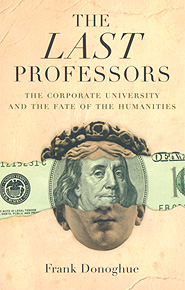The Corporate University and the Fate of the Humanities

Frank Donoghue. New York, NY: Fordham University Press, 2008; 180 pp; ISBN: 978-0-82322-859-1, cloth $70 usd; ISBN: 978-0-82322-860-7, paper $22 USD.
Reviewed by Luciana Marini-Wurdemann
Frank Donoghue offers a startling bleak observation of the erosion of the professoriate in American universities with a specific focus on the humanities professor. He begins his tale by asserting that this is not a new phenomenon, or “crisis” as many recent reports in the news media suggest, but rather a fairly old and well-established fact. He presents this thesis in five well-researched and documented chapters that begin with a historical look at higher education in the U.S. at the turn of the 19th century.
The author plots the gradual erosion of the humanities professor through roughly 80 years of changing social, political and economic times. He considers nearly a century worth of discussion and rhetoric to prove that corporate America and American universities have always been at odds when it comes to higher education and the bygone prestige of a liberal arts education.
Influential Americans like Andrew Carnegie suggested institutions of higher learning should adopt more of a business model and produce graduates with tangible skills who will then be employed as managers in the industrial sector. A liberal arts education was seen as useless in the corporate world and as something that needed to change. This, Donoghue explains, is the beginning of the erosion of the role of the humanities in higher education and the gradual disappearance of the humanities professor.
To further support this thesis, Donoghue examines a number of other factors that have become quasi second nature to higher education administrators both in public and for-profit institutions in the U.S., such as “pre-professionalism,” (p. 40) adjunct professorship, tenure and the role of prestige in higher education. All of these factors add to the continual erosion of higher education in general with the humanities discipline and the professor paying the ultimate price.
He explores the highly competitive graduate student and adjunct professors as subcategories of higher education labour, describing their financial compensation as irresponsible. Although he suggests a possible solution would be unionization of these vast armies of academics, he is critical of existing labour movements. Donoghue says unionization “may secure short-term victories for both groups in the form of fairer wages and benefits. (They) will not, though, stop the eventual disappearance of professors.” (p. 69) Labour movements in the U.S. do not address the fundamental issues affecting the humanities and Donoghue does not offer any suggestions about how to deal with these issues.
On the subject of tenure, Donoghue dismantles the belief that with tenure comes academic freedom. He notes that although the two are linked, “academic freedom no longer packs the theoretical punch that it was meant to” (p. 73) and that public antagonism for the tenured professor has added to the list of issues modern humanists face. To add more fuel to this fire, he also suggests that many academics romanticize their work and fail to “recognize how the tenure process works to deaden the possibility of radical freedom of expression.” (p. 183)
Although some tenured professors would disagree with this assertion, Donoghue makes a rather convincing argument because of his personal perspective of these issues. Being an associate professor in the Department of English at Ohio State University, Dono-ghue fulfills the requirement of research in writing this book and, ironically, also proves his point.
Another fact Donoghue accepts as irrefutable is that the student has become a consumer of higher education and has attached a monetary value to a university degree. Institutions have tailored programs to meet a consumer need and only the more commercially-viable programs get adequate funding.
All of these arguments unmistakably lead to the conclusion that a liberal arts education is no longer “sexy” or valuable unless one is wealthy enough to attend prestigious universities such as Harvard, Stanford and a few others. Donoghue sees a liberal arts degree from these schools as a prestigious stepping-stone towards more specialized accreditation, like law school, medical school and other professional designations. This also echoes the early assertions of the industrial giants and is a prevalent theme throughout the book.
The cherry on the sundae though belongs to the for-profit institutions, which have made higher education even more accessible by offering e-learning and block courses that easily fit into busy schedules, allowing students to continue working and earning a degree at the same time. These schools have also eliminated research as part of their mission as well as “the figure of the professor from higher education.” (p. 89)
They have turned faculty into facilitators whose sole responsibility is to transmit information to students. As a result, the current state of higher education in America is as closely tied to the employment market and corporate values as it was at the turn of the 19th century.
All of these issues deserve more study, but it is clear to Donoghue that further study will not provide a sustainable solution. What was once deemed a sound liberal arts education is no longer considered useful or prestigious. The author’s personal perspective helps him make a convincing argument that what is happening to the humanities and academics in these disciplines has a long history, has barely survived several twists in its story, and is in need of reinvention to stay alive.
Then again, is it absolutely necessary to continually reinvent to keep alive a disappearing discipline? What would happen if we just gave up? It is clear to Donoghue that unless there is drastic action to resolve fundamental issues, the humanities and humanities professors will eventually go the way of the dinosaur.
---------------------------------------------------------------
Luciana Marini-Wurdemann is a teaching adjunct professor in Italian at Algoma University in Sault Ste. Marie, Ontario.